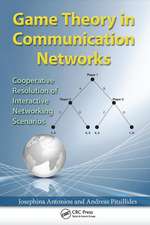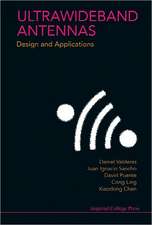Shaping the Future of ICT: Trends in Information Technology, Communications Engineering, and Management
Editat de Ibrahiem M. M. El Emary, Anna Brzozowskaen Limba Engleză Hardback – 13 iul 2017
| Toate formatele și edițiile | Preț | Express |
|---|---|---|
| Paperback (1) | 361.92 lei 6-8 săpt. | |
| CRC Press – 30 iun 2020 | 361.92 lei 6-8 săpt. | |
| Hardback (1) | 958.89 lei 6-8 săpt. | |
| CRC Press – 13 iul 2017 | 958.89 lei 6-8 săpt. |
Preț: 958.89 lei
Preț vechi: 1309.46 lei
-27% Nou
Puncte Express: 1438
Preț estimativ în valută:
183.54€ • 192.83$ • 154.25£
183.54€ • 192.83$ • 154.25£
Carte tipărită la comandă
Livrare economică 11-25 martie
Preluare comenzi: 021 569.72.76
Specificații
ISBN-13: 9781498781183
ISBN-10: 1498781187
Pagini: 520
Ilustrații: 450
Dimensiuni: 178 x 254 x 38 mm
Greutate: 1.09 kg
Ediția:1
Editura: CRC Press
Colecția CRC Press
ISBN-10: 1498781187
Pagini: 520
Ilustrații: 450
Dimensiuni: 178 x 254 x 38 mm
Greutate: 1.09 kg
Ediția:1
Editura: CRC Press
Colecția CRC Press
Cuprins
Section I INFORMATION TECHNOLOGY
Chapter 1 Computer Vision for Object Recognition and Tracking Based on Raspberry Pi
Ali A. Abed and Sara A. Rahman
Chapter 2 Modeling of the Teaching・Learning Process in E-Learning
Mustapha Bassiri, Mohamed Radid, and Said Belaaouad
Chapter 3 Solving the Problems of Linguistically Diverse First-Year University
Students Using Digital Learning
Dace Ratniece and Sarma Cakula
Chapter 4 Moving Enterprise Architecture from Professional Certificates to
Academic Credentials
Fekry Fouad
Chapter 5 Automatic Identification and Data Capture Techniques by Radio-Frequency
Identification (RFID) Tags: Reader Authentication and Ethical Aspects
H. Saadi, R. Touhami, and M. C. E. Yagoub
Chapter 6 Artificial Intelligence in E-Learning
Hachem Alaoui Harouni, Elkaber Hachem, and Cherif Ziti
Chapter 7 Wireless Multimedia Sensor Networks: Cross-Layer Approach Protocols
Manal Abdullah and Ablah AlAmri
Chapter 8 Survey of E-Learning Standards
Manal Abdullah and Nashwa AbdelAziz Ali
Chapter 9 A Classification Perspective of Big Data Mining
Manal Abdullah and Nojod M. Alotaibi
Chapter 10 Streaming Data Classification in Clustered Wireless Sensor Networks
Manal Abdullah and Yassmeen Alghamdi
Chapter 11 Video Codecs Assessment over IPTV Using OPNET
Eman S. Sabry, Rabie A. Ramadan, M. H. Abd El-Azeem, and Hussien ElGouz
Chapter 12 Brain Storm Optimization (BSO) for Coverage and Connectivity Problems
in Wireless Sensor Networks
Rabie A. Ramadan and A. Y. Khedr
Chapter 13 An Exploratory Evaluation of the Awareness of E-Government
Services among Citizens in Saudi Arabia
S. Q. Al-Khalidi Al-Maliki
Chapter 14 An Internet of Things (IoT) Course for a Computer Science Graduate Program
Xing Liu and Orlando Baiocchi
Chapter 15 Modeling Guidelines of FreeRTOS in Event-B
Eman H. Alkhammash, Michael J. Butler, and Corina Cristea
Chapter 16 Generation of Use Case UML Diagram from User Requirement
Specifications
Wahiba Ben Abdessalem and Eman H. Alkhammash
Section II COMMUNICATION SYSTEMS
Chapter 17 Design and Simulation of Adaptive Cognitive Radio Based on Software-
Defined Radio (SDR) Using Higher-Order Moments and Cumulants
Ahmed Abdulridha Thabit and Hadi T. Ziboon
Chapter 18 Effect of Black Hole Attacks on Delay-Tolerant Networks
Alaa Hassan and Wafa Ahmed El Gali
Chapter 19 Proposed Adaptive Neural-Fuzzy Inference System (ANFIS) Identifier
for M-ary Frequency Shift Keying (FSK) Signals with Low SNR
Hadi A. Hamed, Sattar B. Sadkhan, and Ashwaq Q. Hameed
Chapter 20 New Image Scrambling Algorithm Depending on Image
Dimension Transformation Using Chaotic Flow Sequences
Hadi T. Ziboon, Hikmat N. Abdullah, and Atheer J. Mansor
Chapter 21 Efficient Two-Stage Sensing Method for Improving Energy Consumption
in Cognitive Radio Networks
Hikmat N. Abdullah and Hadeel S. Abed
Chapter 22 Current Status of Information Security Based on Hybrid Crypto
and Stego Systems
Rana Saad Mohammed and Sattar B. Sadkhan
Chapter 23 The Status of Research Trends in Text Emotion Detection
Rusul Sattar B. Sadkhan and Sattar B. Sadkhan
Chapter 24 Reaction Automata Direct Graph (RADG) Design on Elliptic
Curve Cryptography
Salah A. Albermany and Ali Hasan Alwan
Chapter 25 A Performance Comparison of Adaptive LMS, NLMS, RLS,
and AFP Algorithms for Wireless Blind Channel Identification
Sami Hasan and Anas Fadhil
Chapter 26 Design of New Algorithms to Analyze RC4 Cipher Based on Its Biases
Ali M. Sagheer and Sura M. Searan
Chapter 27 Extracting Implicit Feedback from Users’ GPS Tracks Dataset:
A New Developed Method for Recommender Systems
Tawfiq A. Alasadi and Wadhah R. Baiee
Section III MANAGEMENT
Chapter 28 Management through Opportunities as an Unconventional Solution
in the Theory of Strategic Management
Anna Brzozowska and Katarzyna Szymczyk
Chapter 29 Concept of Supply Chain Management in the Context of Shaping Public Value
Dagmara Bubel
Chapter 30 Current State of Information and Communication Provision of Ukraine
and Spread of Information Technologies in Agricultural Sector
Antonina Kalinichenko and Oleksandr Chekhlatyi
Chapter 31 Selected Issues of Management of Green Logistics in Transport Sector
Marta Kadłubek
Chapter 32 HR Analytics as a Support of High- and Mid-Level Managers
in Contemporary Enterprises in Eastern Poland
Monika Wawer and Piotr Muryjas
Chapter 33 Effects and Impact of Playing Computer Games on Gamers
W. Chmielarz and O. Szumski
Chapter 34 ICT Drivers of Intelligent Enterprises
Monika Łobaziewicz
Chapter 35 MVDR Beamformer Model for Array Response Vector Mismatch Reduction
Suhail Najm Shahab, Ayib Rosdi Zainun, Essa Ibrahim Essa, Nurul Hazlina
Noordin, Izzeldin Ibrahim Mohamed, and Omar Khaldoon
Chapter 1 Computer Vision for Object Recognition and Tracking Based on Raspberry Pi
Ali A. Abed and Sara A. Rahman
Chapter 2 Modeling of the Teaching・Learning Process in E-Learning
Mustapha Bassiri, Mohamed Radid, and Said Belaaouad
Chapter 3 Solving the Problems of Linguistically Diverse First-Year University
Students Using Digital Learning
Dace Ratniece and Sarma Cakula
Chapter 4 Moving Enterprise Architecture from Professional Certificates to
Academic Credentials
Fekry Fouad
Chapter 5 Automatic Identification and Data Capture Techniques by Radio-Frequency
Identification (RFID) Tags: Reader Authentication and Ethical Aspects
H. Saadi, R. Touhami, and M. C. E. Yagoub
Chapter 6 Artificial Intelligence in E-Learning
Hachem Alaoui Harouni, Elkaber Hachem, and Cherif Ziti
Chapter 7 Wireless Multimedia Sensor Networks: Cross-Layer Approach Protocols
Manal Abdullah and Ablah AlAmri
Chapter 8 Survey of E-Learning Standards
Manal Abdullah and Nashwa AbdelAziz Ali
Chapter 9 A Classification Perspective of Big Data Mining
Manal Abdullah and Nojod M. Alotaibi
Chapter 10 Streaming Data Classification in Clustered Wireless Sensor Networks
Manal Abdullah and Yassmeen Alghamdi
Chapter 11 Video Codecs Assessment over IPTV Using OPNET
Eman S. Sabry, Rabie A. Ramadan, M. H. Abd El-Azeem, and Hussien ElGouz
Chapter 12 Brain Storm Optimization (BSO) for Coverage and Connectivity Problems
in Wireless Sensor Networks
Rabie A. Ramadan and A. Y. Khedr
Chapter 13 An Exploratory Evaluation of the Awareness of E-Government
Services among Citizens in Saudi Arabia
S. Q. Al-Khalidi Al-Maliki
Chapter 14 An Internet of Things (IoT) Course for a Computer Science Graduate Program
Xing Liu and Orlando Baiocchi
Chapter 15 Modeling Guidelines of FreeRTOS in Event-B
Eman H. Alkhammash, Michael J. Butler, and Corina Cristea
Chapter 16 Generation of Use Case UML Diagram from User Requirement
Specifications
Wahiba Ben Abdessalem and Eman H. Alkhammash
Section II COMMUNICATION SYSTEMS
Chapter 17 Design and Simulation of Adaptive Cognitive Radio Based on Software-
Defined Radio (SDR) Using Higher-Order Moments and Cumulants
Ahmed Abdulridha Thabit and Hadi T. Ziboon
Chapter 18 Effect of Black Hole Attacks on Delay-Tolerant Networks
Alaa Hassan and Wafa Ahmed El Gali
Chapter 19 Proposed Adaptive Neural-Fuzzy Inference System (ANFIS) Identifier
for M-ary Frequency Shift Keying (FSK) Signals with Low SNR
Hadi A. Hamed, Sattar B. Sadkhan, and Ashwaq Q. Hameed
Chapter 20 New Image Scrambling Algorithm Depending on Image
Dimension Transformation Using Chaotic Flow Sequences
Hadi T. Ziboon, Hikmat N. Abdullah, and Atheer J. Mansor
Chapter 21 Efficient Two-Stage Sensing Method for Improving Energy Consumption
in Cognitive Radio Networks
Hikmat N. Abdullah and Hadeel S. Abed
Chapter 22 Current Status of Information Security Based on Hybrid Crypto
and Stego Systems
Rana Saad Mohammed and Sattar B. Sadkhan
Chapter 23 The Status of Research Trends in Text Emotion Detection
Rusul Sattar B. Sadkhan and Sattar B. Sadkhan
Chapter 24 Reaction Automata Direct Graph (RADG) Design on Elliptic
Curve Cryptography
Salah A. Albermany and Ali Hasan Alwan
Chapter 25 A Performance Comparison of Adaptive LMS, NLMS, RLS,
and AFP Algorithms for Wireless Blind Channel Identification
Sami Hasan and Anas Fadhil
Chapter 26 Design of New Algorithms to Analyze RC4 Cipher Based on Its Biases
Ali M. Sagheer and Sura M. Searan
Chapter 27 Extracting Implicit Feedback from Users’ GPS Tracks Dataset:
A New Developed Method for Recommender Systems
Tawfiq A. Alasadi and Wadhah R. Baiee
Section III MANAGEMENT
Chapter 28 Management through Opportunities as an Unconventional Solution
in the Theory of Strategic Management
Anna Brzozowska and Katarzyna Szymczyk
Chapter 29 Concept of Supply Chain Management in the Context of Shaping Public Value
Dagmara Bubel
Chapter 30 Current State of Information and Communication Provision of Ukraine
and Spread of Information Technologies in Agricultural Sector
Antonina Kalinichenko and Oleksandr Chekhlatyi
Chapter 31 Selected Issues of Management of Green Logistics in Transport Sector
Marta Kadłubek
Chapter 32 HR Analytics as a Support of High- and Mid-Level Managers
in Contemporary Enterprises in Eastern Poland
Monika Wawer and Piotr Muryjas
Chapter 33 Effects and Impact of Playing Computer Games on Gamers
W. Chmielarz and O. Szumski
Chapter 34 ICT Drivers of Intelligent Enterprises
Monika Łobaziewicz
Chapter 35 MVDR Beamformer Model for Array Response Vector Mismatch Reduction
Suhail Najm Shahab, Ayib Rosdi Zainun, Essa Ibrahim Essa, Nurul Hazlina
Noordin, Izzeldin Ibrahim Mohamed, and Omar Khaldoon
Notă biografică
Ibrahim M. M. El Emary received the Dr. Eng. Degree in 1998 from the Electronic and Communication Department, Faculty of Engineering, Ain shams University, Egypt. From 1998 to 2002, he was an Assistant Professor of Computer sciences in different faculties and academic institutionss in Egypt. From 2002 to 2010, he worked as visiting Assis. And Assoc.professor of computer science and engineering in two universities in Jordan. Currently, he is a Professor of computer science and engineering at King Abdulaziz University, Jeddah, Kingdom of Saudi Arabia. His research interests cover: various analytic and discrete event simulation techniques, performance evaluation of communication networks, application of intelligent techniques in managing computer communication network, and performing a comparative studies between various policies and strategies of routing, congestion control, subnetting of computer communication networks. He published more than 150 articles in various refreed international journals and conferences covering: Computer Networks, Artificial Intelligent, Expert Systems, Software Agents, Information Retrieval, E-learning, Case Based Reasoning, Image Processing and Pattern Recognition, Wireless sensor networks, cloud computing and Robotic engineering. Also, he participates in publishing seven book chapters in three international books (Published by Springer Verlag, IGI publisher & NOVA Science Publisher) as well as Editor of two books edited by international publishers (LAP Lampert- Germany).
Descriere
The International Conference on Communications, Management, and Information Technology (ICCMIT’16) provides a discussion forum for scientists, engineers, educators and students about the latest discoveries and realizations in the foundations, theory, models and applications of systems inspired on nature, using computational intelligence methodologies, as well as in emerging areas related to the three tracks of the conference: Communication Engineering, Knowledge, and Information Technology. The best 25 papers to be included in the book will be carefully reviewed and selected from numerous submissions, then revised and expanded to provide deeper insight into trends shaping future ICT.
























